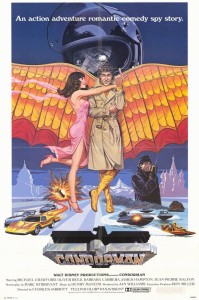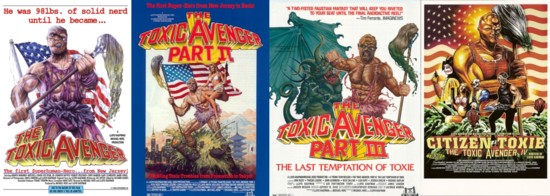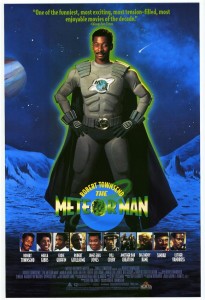In a multi-part series, Comic Book Film Editor William Gatevackes will be tracing the history of comic book movies from the earliest days of the film serials to today’s big blockbusters and beyond. Along with the history lesson, Bill will be covering some of the most prominent comic book films over the years and why they were so special. This time, we’ll talk about superhero films not adapted from any comic book.
 Not every movie starring a superhero is adapted from a comic book but each has been inspired by or in turn inspired comic books. Many of these non-comic book comic book films have sprung up in recent years but they have been appearing in movie theaters for over thirty years. We will dedicate the next few installments to these movies. We’ll try to talk about all of them here, but odds are one or two will slip our notice. Let us know what you think we’ve missed and maybe we’ll include them in a future installment.
Not every movie starring a superhero is adapted from a comic book but each has been inspired by or in turn inspired comic books. Many of these non-comic book comic book films have sprung up in recent years but they have been appearing in movie theaters for over thirty years. We will dedicate the next few installments to these movies. We’ll try to talk about all of them here, but odds are one or two will slip our notice. Let us know what you think we’ve missed and maybe we’ll include them in a future installment.
One of my most fondly remembered superhero movies was 1980’s Hero At Large.
John Ritter stars as Steve Nichols, an underemployed actor who is hired to portray the character Captain Avenger at the opening of a film based on the character. A job that entailed just signing autographs for fans becomes something more when Nichols breaks up a robbery while in costume. The media grabs hold of it, and his life becomes much more complicated. Nichols is compelled to keep fighting crime as Captain Avenger while political interests want to use Nichols for their own interests.
I haven’t seen the film in a while, but it was one of my favorites as a youth. It wasn’t Hamlet, but it wasn’t awful either. Anne Archer, passed over several years prior for Lois Lane in Superman, gets to play a similar part here as Nichols’ neighbor/love interest. Kevin Bacon has a small part in the film as well.
The film made $15,934,737 at the box office that year. That might seem paltry by today’s standards, but it out grossed other, better well known films from that year such as Prom Night, Used Cars, Stardust Memories and Mad Max.
A year later, Disney came out with its take on the superhero, Condorman.
 Hero At Large might have been cheesy, but it was nothing compared to this film. Condorman couldn’t have been cheesier if it was paired with a beef stick and sold at a Hickory Farms kiosk over the holidays. The film has been all but consigned to the dustbin of history by most (the above trailer was put together by a fan), those that do remember it recall it fondly in a “so-bad-it’s-good” sort of way. Michael Crawford, five years before he would take the stage as the Phantom in Andrew Lloyd Webber’s production of Phantom of the Opera, stars as Woody Wilkins, a comic book writer of a character called “Condorman” who is pulled into a spy exchange in Europe. Wilkins adopts the Condorman identity, becomes a spy for the CIA, and rescues a Russian double agent played by Barbara Carrera.
Hero At Large might have been cheesy, but it was nothing compared to this film. Condorman couldn’t have been cheesier if it was paired with a beef stick and sold at a Hickory Farms kiosk over the holidays. The film has been all but consigned to the dustbin of history by most (the above trailer was put together by a fan), those that do remember it recall it fondly in a “so-bad-it’s-good” sort of way. Michael Crawford, five years before he would take the stage as the Phantom in Andrew Lloyd Webber’s production of Phantom of the Opera, stars as Woody Wilkins, a comic book writer of a character called “Condorman” who is pulled into a spy exchange in Europe. Wilkins adopts the Condorman identity, becomes a spy for the CIA, and rescues a Russian double agent played by Barbara Carrera.
In all fairness, the film is more a Disneyfied version of the James Bond-esque spy thriller than an actual comic book, although Crawford does appear in costume as Condorman and uses many Batman-esque gizmos and gadgets. It goes without saying that the film was a critical and commercial flop.
While Condorman probably began with the noblest intentions and wound up at cheesiness accidentally, The Toxic Avenger wallowed in its inherent cheesiness to the fullest extent from the very first day of production, as is the trademark of the studio that released it, Troma Entertainment.
 Whether it was intended to be or not, 1984’s The Toxic Avenger was like all of the Marvel Comics from the 1960s brought to the big screen all wrapped up in one. Toxie, as he is lovingly referred to, starts the film as a nerdy janitor bullied by his peers (much like Peter Parker was before he became Spider-Man). One day, he has an accidental exposure to radioactive materials (like, well, take your pick: Spider-Man, Fantastic Four, The Hulk, Daredevil, any number of other heroes and villains from Marvel at that time) which causes the nebbish to grow into a superhumanly strong creature (like The Hulk). He uses his new power to fight crime in Tromaville, finding love along the way with a blind woman who loves him for who he is and not what he looks like (mimicking a plot point featuring the Fantastic Four’s Thing and blind sculptress Alicia Masters).
Whether it was intended to be or not, 1984’s The Toxic Avenger was like all of the Marvel Comics from the 1960s brought to the big screen all wrapped up in one. Toxie, as he is lovingly referred to, starts the film as a nerdy janitor bullied by his peers (much like Peter Parker was before he became Spider-Man). One day, he has an accidental exposure to radioactive materials (like, well, take your pick: Spider-Man, Fantastic Four, The Hulk, Daredevil, any number of other heroes and villains from Marvel at that time) which causes the nebbish to grow into a superhumanly strong creature (like The Hulk). He uses his new power to fight crime in Tromaville, finding love along the way with a blind woman who loves him for who he is and not what he looks like (mimicking a plot point featuring the Fantastic Four’s Thing and blind sculptress Alicia Masters).
What separated the film from the Marvel Comics of the 1960s was the schlocky, off-center and off-color humor, the violence that was so graphic that it became absurd, and the copious amounts of sex and nudity that is the trademark of the Troma film. But the first film was a success and that spawned a sequel, 1989’s The Toxic Avenger Part II:
When Troma found they shot enough footage for two films, they released another sequel in 1989, The Toxic Avenger Part III: The Last Temptation of Toxie:
And yet another sequel, 2000’s Citizen Toxie: The Toxic Avenger IV:
That last film pulled out all the stops when it came to celebrity cameos, featuring Ron Jeremy, Corey Feldman, Hugh Hefner, and Julie Strain, with Stan Lee serving as narrator.
The Toxic Avenger was also adapted into a short-lived Marvel comic book in 1991 and a stage musical in 2008. A rumored fourth sequel was planned, but might have made way for a PG-13 remake produced by Akiva Goldsman and directed by Hot Tub Time Machine’s Steve Pink.
The next film we are going to discuss was made with noble intentions but became a box office failure. Hollywood Shuffle’s Robert Townsend wanted to make a film that was a counter-point to the popular “gangsta” films such as New Jack City and Juice that dominated cineplexes at the time. So, in 1993, he came up with a film idea that presented a positive black role model that would work to stop black-on-black violence instead of glorify it. That film was The Meteor Man.
 The film told the story of Jefferson Reed, a Washington, DC teacher who is struck by a meteor and given superpowers. He uses these powers to clean up his neighborhood—stopping gang violence, demolishing crack houses, and stopping robberies. While the Toxic Avenger was a mix of a bunch of Marvel superheroes, the Meteor Man seemed to borrow from a number of DC Comics heroes, most notably Superman (who shares most of the same powers and the “mom-made costume” bit) and Black Lightning (DC’s first major black superhero, who was also a teacher named Jefferson Pierce).
The film told the story of Jefferson Reed, a Washington, DC teacher who is struck by a meteor and given superpowers. He uses these powers to clean up his neighborhood—stopping gang violence, demolishing crack houses, and stopping robberies. While the Toxic Avenger was a mix of a bunch of Marvel superheroes, the Meteor Man seemed to borrow from a number of DC Comics heroes, most notably Superman (who shares most of the same powers and the “mom-made costume” bit) and Black Lightning (DC’s first major black superhero, who was also a teacher named Jefferson Pierce).
The film featured a veritable who’s who of the best African-American actors America had to offer, including Bill Cosby, James Earl Jones, and Robert Guillaume and did earnestly try to present a more positive African-American role model. But the film was rather simplistic and the naive (the two gangs in the film, the Bloods and the Crips, put aside their differences to support Meteor Man in his fight against the white drug lord) script led to box-office disappointment.
Next time, we cover three popular movies that might stretch the definition of the superhero, but that had an effect on comic books for years to come.





RT @FilmBuffOnLine: FBOL Headline: HISTORY OF THE COMIC BOOK FILM: The Non-Comic Book Superher…: http://t.co/VwQ0bva5